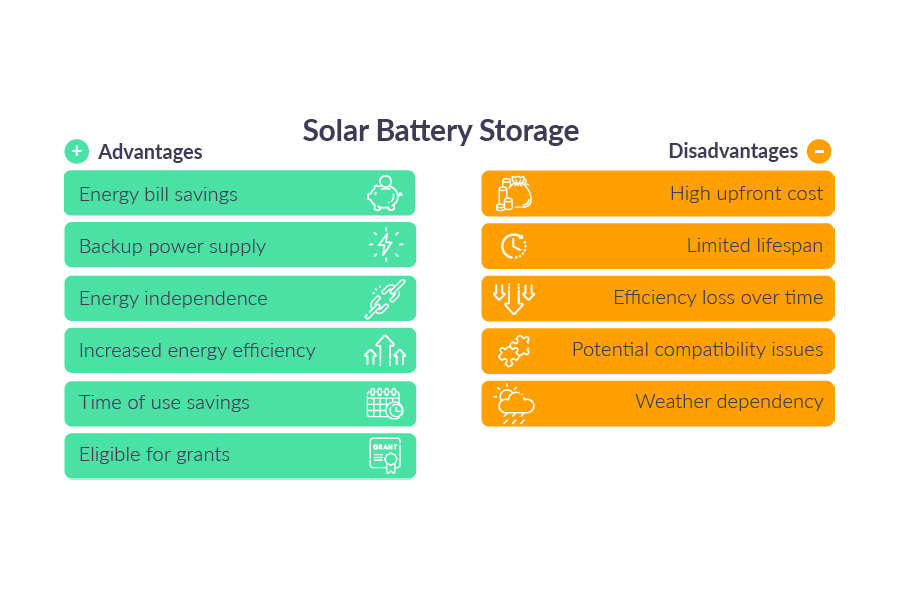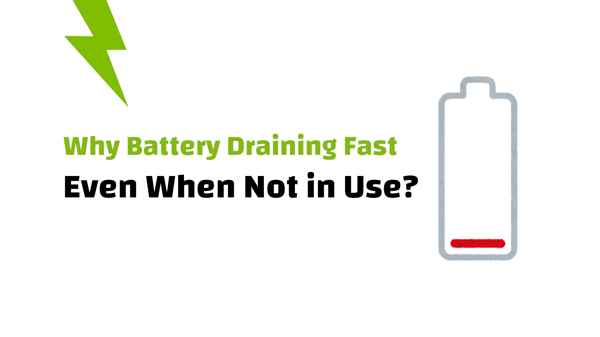Каковы недостатки солнечных батарей?
Солнечные батареи - горячая тема, Перспективная энергетическая независимость и резервная сила. Но, учитывая эту значительную инвестицию, Вы можете спросить: Что за улов? Есть скрытые затраты, Проблемы с производительностью, или другие недостатки, чтобы знать? Четкий взгляд на потенциальные недостатки необходим для умного, уверенное решение о вашем энергетическом будущем.
Основными недостатками солнечных батарей являются их значительная первоначальная стоимость, их конечная жизнь (Все батареи разлагаются со временем), Потери эффективности обращения (ты не уходишь 100% энергии, которую вы вкладываете), и физическое пространство, которое они требуют. Существуют также более широкие экологические соображения, касающиеся их производства и утилизации жизни. Однако, Важно знать, что современная технология батареи, Особенно в гладком «настенного крепления солнечной батареи" системы, быстро продвигается, чтобы смягчить многие из этих проблем, Повышение стоимости и производительности каждый год.

В Гикс Солар, Мы верим в прозрачность. Понимание как профессионалов, так и минусов - это ключ. Пока есть проблемы, Для многих людей, Преимущества устойчивости к энергии и солнечной самообеспеченности намного перевешивают их. Давайте решим ваши самые большие вопросы о потенциальных недостатках.
Сколько лет длится солнечная батарея?
Одной из наиболее важных проблем при инвестировании в солнечную батарею является его срок службы. Вы хотите быть уверенным, что ваша батарея продлится достаточно долго, чтобы обеспечить хорошую отдачу от ваших инвестиций. Как долго вы можете реально ожидать, что он будет выполнять? Ответ сильно варьируется в зависимости от химического макияжа батареи.
Современный ЛФП (Литий-железо-фосфат) солнечная батарея, Тип наиболее часто встречается в современных продвинутых настенное крепление солнечная батарея системы, обычно предназначен для длительного времени 10 к 20 годы. Эти батареи часто поддерживаются комплексными 10-летними гарантиями, которые гарантируют определенный уровень производительности. В отличие, старше, традиционный свинцовая батарея Типы имеют гораздо более короткую оперативную продолжительность жизни, обычно в диапазоне 3 к 7 годы, и требовать более частой замены.

Погрузитесь глубже: Понимание долговечности аккумулятора (Химия является ключевым)
Срок службы батареи измеряется двумя способами: цикл жизни (сколько раз это можно взимать и сбрасывать) и Календарная жизнь (Сколько лет он длится до его химии, естественно, деградирует).
- ЛФП (Литий-железо-фосфат) Батареи: Это ведущая технология для хранения стационарного хранения энергии сегодня, И на то есть причина.
- Цикл жизни: Батареи LFP предлагают впечатляющие 3,000 к 6,000+ глубокие циклы, с некоторыми высококачественными клетками, оцененными еще большим количеством. Это делает их идеальными для ежедневного использования с солнечной панелью системой.
- Календарная жизнь: Их стабильная химия позволяет им длиться 10, 15, или даже до 20 За годы до их потенциала значительно ухудшаются.
- Гарантия: Уважаемые производители обычно предоставляют 10-летнюю гарантию, Часто гарантируя, что батарея сохранится, по крайней мере, 70% его первоначальной емкости к концу этого термина.
- Свинцовые батареи (Затоплен, Заседание, Гель): Это старше, Более традиционные технологии.
- Цикл жизни: Намного ниже LFP, обычно от 300 к 1,000 циклы, в зависимости от конкретного типа и того, насколько глубоко он разряжен.
- Календарная жизнь: В целом 3 к 7 годы. Тепло и глубокий велосипед может значительно сократить это.
- Гарантия: Обычно намного короче, часто в 1 до 5-летнего диапазона.
Другие факторы, такие как рабочая температура батареи (Они предпочитают прохладно, Умеренный климат) и качество системы Система управления батареями (БМС) Также играют огромную роль в максимизации продолжительности жизни. В GYCX Solar, Мы распределяем приоритеты длительной технологии LFP, Как это найдено в современных системах настенных и серверных стоек, Чтобы наши клиенты получали наилучшую долгосрочную ценность и более десяти лет надежного обслуживания от своих инвестиций в хранение энергии.
Что истощает солнечную батарею?
Вы сохранили чистую солнечную энергию в своей батарее - фантастика! Но куда на самом деле уходит эта энергия? Понимание того, что происходит" или использует питание от вашей солнечной батареи является ключом к эффективному управлению энергопотреблением вашего дома.
Основной сток на солнечной батареи, по дизайну, питание вашего дома или электрических нагрузок - такие вещи, как свет, Ваш холодильник, компьютеры, Системы HVAC, и другие приборы. Однако, Есть еще два, меньшие стоки, чтобы знать: тот Собственное резервное энергопотребление инвертора (Сила, которую он использует, просто чтобы остаться и готово) И очень постепенный, естественный саморазряд батареи с течением времени.

Погрузитесь глубже: Отслеживание вашей хранимой энергии
Давайте разберемся, куда уходит энергия:
- Ваши электрические нагрузки: Это основная задача вашей батареи - для обеспечения питания, когда ваши солнечные батареи не производят (ночью) или когда сетка не работает. Каждый свет, который вы включаете, Каждое устройство, которое вы запускаете, рисует питание от батареи. Чем больше вы используете, Чем быстрее он истощает.
- Потребление резервного периода инвертора (или бездействие): Ваш солнечный инвертор (В частности, гибридный инвертор, подключенный к батарее) должен остаться" 24/7 быть готовым к тому, чтобы мгновенно подавать питание переменного тока в ваш дом. Это потребляет небольшое, но постоянное количество питания от батареи, Даже когда у вас нет устройств.. Это может варьироваться от 20 Уотты до конца 100 Уатты в зависимости от модели инвертора. За 12-часовую ночь, Эта небольшая нагрузка может добавить к заметному количеству энергии (НАПРИМЕР., Вспомогательная нагрузка на 50 Вт использует 0.6 кВтч 12 часы).
- Самоуделение: Все батареи медленно теряют заряд со временем из -за внутренних химических процессов. Это неизбежно. Однако, Уровень самодействия значительно варьируется в зависимости от химии.
- Батареи LFP: Иметь очень низкий уровень самостоятельного разряда, Обычно только 1-3% в месяц.
- Свинцовые батареи: Иметь гораздо более высокий уровень самостоятельного разряда, который может быть 3-20% в месяц в зависимости от конкретного типа и температуры окружающей среды.
Этот низкий саморазмер является еще одним ключевым преимуществом технологии LFP, используемой в современных системах солнечных батарейных батареев на стенке.
- Потеря эффективности обратного пути: Пока не «дренаж" так же, Помните, что некоторая энергия теряется как тепло во время зарядки и сброса батареи. Батарея LFP может иметь эффективность обработки 90-95%, значение для каждого 10 кВтч, вы вставили, Вы получаете 9.0-9.5 кВтч полезной энергии обратно.
Понимание этих стоков помогает в правильном размере вашей системы и управлении использованием энергии, чтобы получить максимальную отдачу от каждого сохраненного киловатт-часа.
Почему моя солнечная батарея сливается так быстро ночью?
Одним из наиболее распространенных проблем, которые мы слышим от новых владельцев солнечных батарей, является, "Я чувствую, что моя батарея сливается быстрее, чем я ожидал в течение ночи!" Если это происходит с вами, Не волнуйтесь - обычно есть логические объяснения.
Солнечная батарея может показаться быстро стечь ночью в основном из -за более высокое, чем ожидалось, ночевое использование энергии (из приборов, Системы HVAC, или "фантомные нагрузки"). Другие причины могут включать Значительный резервный розыгрыш мощности от вашего инвертора, имея Система батареи, которая недооценена Для ваших реальных потребностей, или, в некоторых случаях, анонца стареющая батарея, которая естественным образом потеряла часть своей первоначальной емкости хранения.

Погрузитесь глубже: Диагностика быстро дренирующей батареи
Давайте рассмотрим вероятных виновников:
- Высокие ночные нагрузки: Это самая распространенная причина. Вы можете быть удивлены тем, сколько энергии потребляет ваш дом, когда вы спите.
- Основные приборы: Ваша система HVAC работает? Как насчет насоса бассейна, Обогреватель горячей воды на таймере, или зарядка электромобилей? Это все очень большие нагрузки.
- "Призрак" или "вампир" Нагрузки: Много электроники (Телевизоры, кабельные коробки, игровые приставки, Микроволны) Нарисуйте небольшое количество энергии, даже когда" но подключен. Индивидуально они маленькие, Но вместе они могут сложить.
- Инверторская резервная нагрузка: Как упоминалось ранее, Ваш инвертор использует силу, чтобы быть на. Пока маленький, Эта постоянная ничья способствует дренажу в течение ночи.
- Недоставление батареи: Емкость вашей батареи (кВтч) может быть просто слишком маленьким, чтобы покрыть общее потребление энергии в течение ночи. Если вы используете 8 кВтч в течение ночи, но есть только 10 батарея кВтч с 90% Министерство обороны (9 KWH полезно), к утру это будет почти пусто. Правильный размер имеет решающее значение.
- Уничтоженное здоровье батареи: Если вашей батарею несколько лет, он потеряет часть своей первоначальной мощности из -за естественной деградации. Старая батарея, которая когда -то была оценена для 10 кВтч может теперь только держать 8 кВтч, Так что, естественно, почувствует, что он сливается быстрее. Многие современные системы с хорошим BM могут сообщить о состоянии здоровья батареи (СоХ1. ).
- Неверное состояние заряда (SoC) Чтение: В редких случаях, BMS Система может быть осведомлена и сообщает, что батарея 100% Полный, когда это не, приводя к воспринимаемому быстрому падению. Иногда это можно исправить, позволяя аккумулятору пройти полный цикл заряда/разрядки.
GYCX Solar Story: "Мы помогли клиенту, который был озадачен их быстро дренирующей батареей. После просмотра данных мониторинга энергии, Мы обнаружили старый, неэффективная морозилка в их гараже часто велосировала на велосипеде в течение ночи, Используя несколько кВтч. Заменив его новым, Энергетическая модель, Их батарея легко длилась до утра с большим количеством энергии."
Можете ли вы перезарядить солнечную батарею?
С мощным солнцем, сияющим на солнечных батареях, Общая и действительная обеспокоенность заключается в том, может ли вся эта энергия потенциально «перезарядка" и повредить ваш дорогой банк аккумулятор. Это реальный риск с современной технологией?
В любом современном, Профессионально установленная система солнечной батареи, такие как а настенное крепление солнечная батарея единица, практически невозможно перезарядить батарею. Эти системы имеют несколько слоев защиты. Система Система управления батареями (БМС) и контроллер солнечного заряда (который обычно интегрируется в гибридный инвертор) Работайте вместе, чтобы постоянно контролировать состояние заряда аккумулятора и автоматически остановится или резко сократит ток зарядки после полной батареи. Это предотвращает перезарядку и защищает батарею от повреждения.

Погрузитесь глубже: Безопасная сеть современных систем зарядки
Вот как ваша система защищает себя от перезарядки:
- Контроллер солнечного заряда / Гибридный инвертор: Это основной менеджер процесса зарядки вашей батареи. Он не только слепо отправляет питание от солнечных батарей в батарею. Вместо, Он использует сложный многоэтапный профиль зарядки (часто называется объемным, Поглощение, и поплавковые этапы) это специально запрограммировано для химии вашей батареи (НАПРИМЕР., LFP или свинцовый). Когда контроллер ощущает, что напряжение батареи достигло "полного" или "поглощение" Уставная точка, Он удерживает напряжение устойчиво и сужается от тока зарядки. Как только аккумулятор полностью заряжен, Он прекратит отправлять ток или переключаться на очень низкую мощность "Float" Режим, чтобы сохранить его по сравнению с самоуничтожением.
- Система управления аккумуляторами (БМС): Это последняя и самая важная линия защиты. BMS предназначен для отслеживания напряжения каждой ячейки (или группа клеток) внутри аккумулятора. Если, По любой причине, Контроллер заряда должен был выйти из строя, или напряжение ячейки должно было превысить его максимальный безопасный предел, BMS имеет право предпринять защитные действия. Он может отправить сигнал инвертору, чтобы немедленно прекратить зарядку, или во многих случаях, Он может физически открыть внутренний контактор или реле, чтобы отключить батарею от источника зарядки, Эффективное предотвращение сценария завышенных зарядов.
- Когда переизвывается риск? Риск в основном существует в плохо разработанных, DIY Systems, где компоненты несоответствуют, например,, используя простой, нерегулируемое зарядное устройство или контроллер заряда, который неправильно настроен для конкретного напряжения и химии литийной батареи, с которой он подключен к.
В GYCX Solar, Мы используем исключительно качество, Интегрированные системы, такие как современные настенные солнечные батареи или хорошо устроенные растворы на стойке, где батарея, БМС, и инвертор разработаны и сертифицированы для совместной работы в идеальной гармонии. Это гарантирует, что системы наших клиентов не только эффективны, но и принципиально безопасны от таких проблем, как переоценка.
В то время как солнечные батареи имеют недостатки, такие как первоначальные затраты и конечные срок службы., Современные технологии-особенно в системе настенного крепления на основе LFP, сделали их более долговечными, более длительный, и безопаснее, чем когда -либо прежде. Понимая их характеристики и работая с опытным установщиком, Этими недостатками можно эффективно управлять, Сделать их достойными инвестициями в вашу энергетическую безопасность и независимость.
Если у вас есть больше вопросов о вариантах солнечной батареи или вы хотите изучить, как решение батареи на стене может принести пользу вашему дому или бизнесу, Команда в Gycx Solar готова помочь. Свяжитесь с нами для экспертной консультации!
Понять информационную терминологию батарей для лучшего сравнительного понимания здоровья и оценки лития аккумулятора. Это поможет вам выбрать продукт, который лучше соответствует вашим потребностям. ↩
